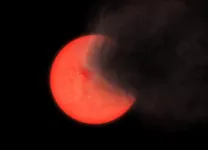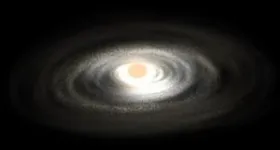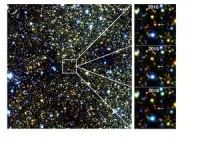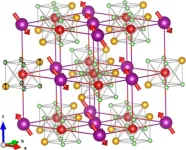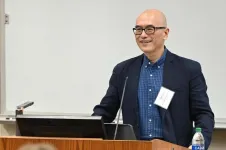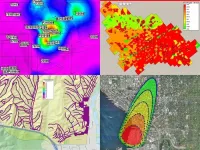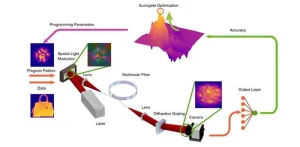(Press-News.org) 'Hidden' stars including a new type of elderly giant nicknamed an 'old smoker' have been spotted for the first time by astronomers.
The mystery objects exist at the heart of our Milky Way galaxy and can sit quietly for decades – fading almost to invisibility – before suddenly puffing out clouds of smoke, according to a new study published today in the Monthly Notices of the Royal Astronomical Society.
An international team of scientists led by Professor Philip Lucas, of the University of Hertfordshire, made their ground-breaking discovery after monitoring almost a billion stars in infrared light during a 10-year survey of the night sky.
They also detected dozens of rarely-seen newborn stars, known as protostars, which undergo extreme outbursts over a period of months, years or decades, as part of the formation of a new solar system.
Most of these newly-spotted stars are hidden from view in visible light by large amounts of dust and gas in the Milky Way – but infrared light can get through, allowing scientists to see them for the first time.
Astronomers from the UK, Chile, South Korea, Brazil, Germany and Italy carried out their research with the help of the Visible and Infrared Survey Telescope (VISTA) – a British-built telescope high in the Chilean Andes at Cerro Paranal Observatory, which is part of the European Southern Observatory (ESO).
The team kept a watchful eye on hundreds of millions of stars and analysed 222 that showed the largest changes in brightness.
Professor Lucas said: "About two-thirds of the stars were easy to classify as well-understood events of various types.
"The rest were a bit more difficult so we used ESO's Very Large Telescope to get spectra of many of them individually. A spectrum shows us how much light we can see at a spread of different wavelengths, giving a much clearer idea of what we are looking at."
The work was carried out as part of a long-term survey called 'VISTA Variables in the Via Lactea', or VVV.
Dr Zhen Guo, formerly of the University of Hertfordshire and now based at the University of Valparaiso in Chile, led the work on the spectra.
He said: "Our main aim was to find rarely-seen newborn stars, also called protostars, while they are undergoing a great outburst that can last for months, years, or even decades.
"These outbursts happen in the slowly spinning disc of matter that is forming a new solar system. They help the newborn star in the middle to grow, but make it harder for planets to form.
"We don't yet understand why the discs become unstable like this."
The team discovered 32 erupting protostars that increased in brightness at least 40-fold, and in some cases over 300-fold.
Most of the eruptions are still ongoing, allowing astronomers for the first time to analyse a large batch of these mysterious events throughout their evolution – from the initial quiescent state, through the peak of brightness, and into the declining stage.
However, the study also threw up something completely unexpected.
There were 21 red stars near the centre of the Milky Way that showed ambiguous changes in brightness during the 10-year survey.
Professor Lucas explained: "We weren't sure if these stars were protostars starting an eruption, or recovering from a dip in brightness caused by a disc or shell of dust in front of the star – or if they were older giant stars throwing off matter in the late stages of their life."
Analysis of the spectra for seven of these stars, compared with data from earlier surveys, concluded that they were in fact a new type of red giant star.
Professor Dante Minniti at Andrés Bello University, Chile, founder of the VVV survey, said: "These elderly stars sit quietly for years or decades and then puff out clouds of smoke in a totally unexpected way.
"They look very dim and red for several years, to the point that sometimes we can't see them at all."
A further clue about this new discovery lies in the location of these dwindling giant stars. They are heavily concentrated in the innermost part of the Milky Way, known as the Nuclear Disc, a region where stars tend to be richer in heavy elements than anywhere else.
This should make it easier for dust particles to condense out of gas in the relatively cool outer layers of red giant stars. However, how this leads to the ejection of puffs of dense smoke that the team observed remains a mystery.
The researchers said their discoveries could change what we know about the way that elements are distributed across space, as Professor Lucas explains.
"Matter ejected from old stars plays a key role in the life cycle of the elements, helping to form the next generation of stars and planets," he said.
"This was thought to occur mainly in a well-studied type of star called a Mira variable.
"However, the discovery of a new type of star that throws off matter could have wider significance for the spread of heavy elements in the Nuclear Disc and metal-rich regions of other galaxies."
The papers 'The most variable VVV sources: eruptive protostars, dipping giants in the Nuclear Disc and others', 'Spectroscopic confirmation of high-amplitude eruptive YSOs and dipping giants from the VVV survey' and 'On the incidence of episodic accretion in Class I YSOs from VVV' have all been published in the Monthly Notices of the Royal Astronomical Society.
Media contacts
Sam Tonkin
Royal Astronomical Society
Mob: +44 (0)7802 877700
press@ras.ac.uk
Robert Massey
Royal Astronomical Society
Mob: +44 (0)7802 877699
press@ras.ac.uk
Images and captions
All images in this release are public domain. They are available at: https://drive.google.com/drive/folders/1p1BXAyLuJhebDXQoi5MXiHCn5Ss_Muyd?usp=drive_link
A newborn star erupts (sf210_graphic.tiff): Buried deep inside the dark cloud of gas and dust that fills the picture, this star gradually brightened 40-fold over the course of 2 years and has remained bright since 2015. The cause of such events is not clearly understood. This infrared image shows what we would see if our eyes were sensitive to wavelengths 3 times longer than visible light.
Red giant star (s163_graphic.tiff): Infrared images of a red giant star about 30,000 light years away, near the centre of our Milky Way galaxy, that faded away and then reappeared over the course of several years.
Newborn star eruption (FUor_artwork.tiff): Artist’s impression of an eruption in the disc of matter around a newborn star. The innermost part of the disc becomes hotter than the star itself.
Obscured red giant star (IMG_1808.tiff): Artist’s impression of a cloud of smoke and dust being thrown out by a red giant star. Seen from the left the star remains bright but if viewed from the right it fades to invisibility.
Science contacts
Professor Philip Lucas, University of Hertfordshire
p.w.lucas@herts.ac.uk
Tel: +44 (0)7951 630957
Professor Dante Minniti, Universidad Andres Bello, Chile, the Vatican Observatory and Universidade Federal de Santa Catarina, Brazil
vvvdante@gmail.com
Tel: +562 2661 7893
Further information
The papers will be available via the links below once the embargo lifts. To view a copy of them before this, contact press@ras.ac.uk
https://academic.oup.com/mnras/article-lookup/doi/10.1093/mnras/stad3929
https://academic.oup.com/mnras/article-lookup/doi/10.1093/mnras/stad3700
https://academic.oup.com/mnras/article-lookup/doi/10.1093/mnras/stad3780
https://academic.oup.com/mnrasl/article-lookup/doi/10.1093/mnrasl/slad201
Researchers and affiliations
Philip W. Lucas 1 , Zhen Guo 2, 3, 1, 4, Carlos Contreras Peña 5, Leigh Smith 6, Dante Minniti 7, 8, 9, Radostin Kurtev 2, 10, Jura Borissova 2, 10, Niall Miller 1, Javier Alonso-García 11, 10, Marcio Catelan 12,10, Sergey Yurchenko 13, Roberto K. Saito 9, Amelia Bayo 14, Dirk Froebrich 15, Alessio Caratti o Garatti 16, Maria Gabriela Navarro 17, Calum Morris 1, Hariharan D.S. Muthu 1, Valentin D. Ivanov 14, Jason L. Sanders 13, Jonathan Tennyson 13, K. Maucó 9, 3, A. Aguayo 2, 3.
(1) University of Hertfordshire, Hatfield, UK
(2) Universidad de Valparaí́so, Valparaí́so, Chile
(3) Núcleo Milenio de Formación Planetaria, Valparaíso, Valparaíso, Chile
(4) Universidad Técnica Federico Santa María, Valparaíso, Chile
(5) Seoul National University, Seoul, Republic of Korea
(6) University of Cambridge, Cambridge, UK
(7) Universidad Andres Bello, Santiago, Chile
(8) Vatican Observatory, Vatican City State, Italy
(9) Universidade Federal de Santa Catarina, Florianópolis, Brazil
(10) Millennium Institute of Astrophysics, Santiago, Chile
(11) Universidad de Antofagasta, Antofagasta, Chile
(12) Pontificia Universidad Católica de Chile, Santiago, Chile
(13) University College London, London, UK
(14) European Southern Observatory, Garching, Germany
(15) University of Kent, Canterbury, UK
(16) Osservatorio Astronomico di Capodimonte, Napoli, Italy
(17) Osservatorio Astronomico di Roma, Monte Porzio Catone, Italy
Notes for editors
About the Royal Astronomical Society
The Royal Astronomical Society (RAS), founded in 1820, encourages and promotes the study of astronomy, solar-system science, geophysics and closely related branches of science. The RAS organises scientific meetings, publishes international research and review journals, recognises outstanding achievements by the award of medals and prizes, maintains an extensive library, supports education through grants and outreach activities and represents UK astronomy nationally and internationally. Its more than 4,000 members (Fellows), a third based overseas, include scientific researchers in universities, observatories and laboratories as well as historians of astronomy and others.
The RAS accepts papers for its journals based on the principle of peer review, in which fellow experts on the editorial boards accept the paper as worth considering. The Society issues press releases based on a similar principle, but the organisations and scientists concerned have overall responsibility for their content.
Keep up with the RAS on:
X: https://twitter.com/RoyalAstroSoc
Facebook: https://www.facebook.com/RoyalAstroSoc/
LinkedIn: https://www.linkedin.com/company/royalastrosoc
YouTube: https://www.youtube.com/user/RoyalAstroSoc/feed
About the University of Hertfordshire
From our pioneering beginnings as a leading educator within Britain’s aeronautical industry to our extensive offering today, we have always specialised in providing the environment and expertise needed to power every kind of potential. We target and fill key skills gaps. We deliver globally-recognised research. And we partner with industry to drive innovation and growth, here in the region and well beyond.
For our thriving community of more than 30,000 students from over 140 countries, that means high- quality teaching from experts engaged in pioneering research with real-world impact. Access to over 550 career-focused degree options and a chance to study at more than 170 universities worldwide. And industry connections that offer professional networking opportunities which take talents even further.
Herts: Discover a place where ideas move at a different pace.
Visit herts.ac.uk
about astrophysics research at the University of Hertfordshire here: https://www.herts.ac.uk/research/centres/car
About VISTA
Visible and Infrared Survey Telescope (VISTA), a British-built telescope high in the Chilean Andes at Cerro Paranal Observatory, part of the European Southern Observatory (ESO). VISTA was designed to survey large parts of the sky with a 67 Mega-pixel infrared camera, the largest of its type in the world.
END
'Old smokers' and 'squalling newborns' among hidden stars spotted for first time
'Hidden' stars including a new type of elderly giant nicknamed an 'old smoker' have been spotted for the first time by astronomers.
2024-01-26
ELSE PRESS RELEASES FROM THIS DATE:
In search of muons: Why they switch sites in antiferromagnetic oxides
2024-01-26
Muon spectroscopy is an important experimental technique that scientists use to study the magnetic properties of materials. It is based on “implanting” a spin-polarized muon in the crystal and measuring how its behavior is affected by the surroundings. The technique relies on the idea that the muon will occupy a well-identified site that is mainly determined by electrostatic forces, and that can be found by calculating the material’s electronic structure.
But a new study led by scientists in Italy, Switzerland, UK and Germany has found that, at least for some materials, that is not the end of the story: the muon site ...
Locked-in syndrome is predominant outcome when children survive drowning, larger study confirms
2024-01-26
SAN ANTONIO, Jan. 25, 2024 — It is a far cry from the traditionally thought-of “vegetative state” in which the mind is absent while the body lives on. Indeed, it is the opposite. Children with “locked-in syndrome,” unable to move or speak, are awake and fully aware of their surroundings.
Researchers from The University of Texas Health Science Center at San Antonio (UT Health San Antonio) were the first to report in peer-reviewed medical literature that, after non-fatal drownings, children would be locked in. The team, directed by Peter T. Fox, MD, professor of radiology and neurology and director of UT ...
Achieving sustainable urban growth on a global scale
2024-01-25
From the impacts on the environment and climate to transforming land cover and habitats, urban growth is driving global change. Urban areas contribute up to 75% of global greenhouse gas emissions. By 2050, urban areas globally will either double or triple, and the raw materials needed to build future cities is more than the world can sustainably provide.
Yet, the impacts of cities on Earth systems are not factored into policy and planning among international agencies and that needs to change, says Karen Seto, Frederick ...
Illinois Tech professor Chun Liu honored as 2024 Fellow by American Mathematical Society
2024-01-25
CHICAGO—January 25, 2024—Illinois Institute of Technology (Illinois Tech) Professor Chun Liu has been elected a 2024 fellow of the American Mathematical Society (AMS)—one of just 40 mathematical scientists to be honored this year for his contribution to mathematics.
“It’s nice to be recognized by my colleagues, but this also gives visibility for the whole department and Illinois Tech,” says Liu, chair of the Department of Applied Mathematics. “It’s great recognition for the mathematics research that’s going on here at Illinois Tech.”
Liu’s research includes partial differential ...
Chats with AI shift attitudes on climate change, Black Lives Matter
2024-01-25
MADISON — People who were more skeptical of human-caused climate change or the Black Lives Matter movement who took part in conversation with a popular AI chatbot were disappointed with the experience but left the conversation more supportive of the scientific consensus on climate change or BLM. This is according to researchers studying how these chatbots handle interactions from people with different cultural backgrounds.
Savvy humans can adjust to their conversation partners’ political leanings and cultural expectations to make sure they’re understood, but more and more often, humans find themselves in ...
PNNL Software Technology wins FLC Award
2024-01-25
RICHLAND, Wash.—Visual Sample Plan (VSP), a free software tool developed at the Department of Energy's Pacific Northwest National Laboratory (PNNL) that boosts statistics-based planning, has been recognized with a 2024 Federal Laboratory Consortium (FLC) Award.
The FLC represents over 300 federal laboratories, agencies, and research centers. The annual FLC awards program recognizes agencies for their contributions to technology transfer, which turns innovative research into impactful products and services.
Judges bestowed ...
Programming light propagation creates highly efficient neural networks
2024-01-25
Current artificial intelligence models utilize billions of trainable parameters to achieve challenging tasks. However, this large number of parameters comes with a hefty cost. Training and deploying these huge models require immense memory space and computing capability that can only be provided by hangar-sized data centers in processes that consume energy equivalent to the electricity needs of midsized cities. The research community is presently making efforts to rethink both the related computing hardware and the machine learning algorithms to sustainably keep the development of artificial intelligence at its current pace.
Optical implementation ...
Advincula earns prestigious NAI fellow honor
2024-01-25
Rigoberto “Gobet” Advincula has been awarded one of the highest honors of his profession.
Advincula, the University of Tennessee-Oak Ridge National Laboratory Governor’s Chair of Advanced and Nanostructured Materials, has been elected National Academy of Inventors (NAI) Fellow.
Advincula is a leader in the polymer field with inventions and many publications in polymer nanocomposites, graphene nanomaterials, polymer layered films, and coatings. He has been granted 14 US patents and has 21 published filings related to graphene nanomaterials, solid-state device fabrication, smart coatings and films, ...
Sweat-analyzing temporary tattoo research funded in NSF grant to UMass Amherst researcher
2024-01-25
AMHERST – University of Massachusetts Amherst researchers have received an award to develop a new type of sweat monitor that can be applied to the skin just like a temporary tattoo and assess the molecules present, such as cortisol. The tattoos will ultimately give individuals better insight into their health and serve as a tool for researchers to discover new early indications of diseases.
“There are a lot of vital biomolecules that are present in sweat that we need to measure to really understand overall human performance and correlation to different ...
Simulations show how HIV sneaks into the nucleus of the cell
2024-01-25
Because viruses have to hijack someone else’s cell to replicate, they’ve gotten very good at it—inventing all sorts of tricks.
A new study from two University of Chicago scientists has revealed how HIV squirms its way into the nucleus as it invades a cell.
According to their models, the HIV capsid, which is cone-shaped, points its smaller end into the pores of the nucleus and then ratchets itself in. Once the pore is open enough, the capsid is elastic enough to squeeze through. Importantly, the scientists ...
LAST 30 PRESS RELEASES:
New study shows how the spleen helps the immune system accept a transplant
New Mayo Clinic study advances personalized prostate cancer education with an EHR-integrated AI agent
Researchers identify novel therapeutic target to improve recovery after nerve injury
Microbes in breast milk help populate infant gut microbiomes
Reprogramming immunity to rewrite the story of Type 1 diabetes
New tool narrows the search for ideal material structures
Artificial saliva containing sugarcane protein helps protect the teeth of patients with head and neck cancer
Understanding the role of linear ubiquitination in T-tubule biogenesis
Researchers identify urban atmosphere as primary reservoir of microplastics
World’s oldest arrow poison – 60,000-year-old traces reveal early advanced hunting techniques
Bristol scientists discover early sponges were soft
New study uncovers how rice viruses manipulate plant defenses to protect insect vectors
NSF–DOE Vera C. Rubin Observatory spots record-breaking asteroid in pre-survey observations
Ribosomal engineering creates “super-probiotic” bacteria
This self-powered eye tracker harnesses energy from blinking and is as comfortable as everyday glasses
Adverse prenatal exposures linked to higher rates of mental health issues, brain changes in adolescents
Restoring mitochondria shows promise for treating chronic nerve pain
Nature study identifies a molecular switch that controls transitions between single-celled and multicellular forms
USU chemists' CRISPR discovery could lead to single diagnostic test for COVID, flu, RSV
Early hominins from Morocco reveal an African lineage near the root of Homo sapiens
Small chimps, big risks: What chimps show us about our own behavior
We finally know how the most common types of planets are created
Thirty-year risk of cardiovascular disease among healthy women according to clinical thresholds of lipoprotein(a)
Yoga for opioid withdrawal and autonomic regulation
Gene therapy ‘switch’ may offer non-addictive pain relief
Study shows your genes determine how fast your DNA mutates with age
Common brain parasite can infect your immune cells. Here's why that's probably OK
International experts connect infections and aging through cellular senescence
An AI–DFT integrated framework accelerates materials discovery and design
Twist to reshape, shift to transform: Bilayer structure enables multifunctional imaging
[Press-News.org] 'Old smokers' and 'squalling newborns' among hidden stars spotted for first time'Hidden' stars including a new type of elderly giant nicknamed an 'old smoker' have been spotted for the first time by astronomers.
